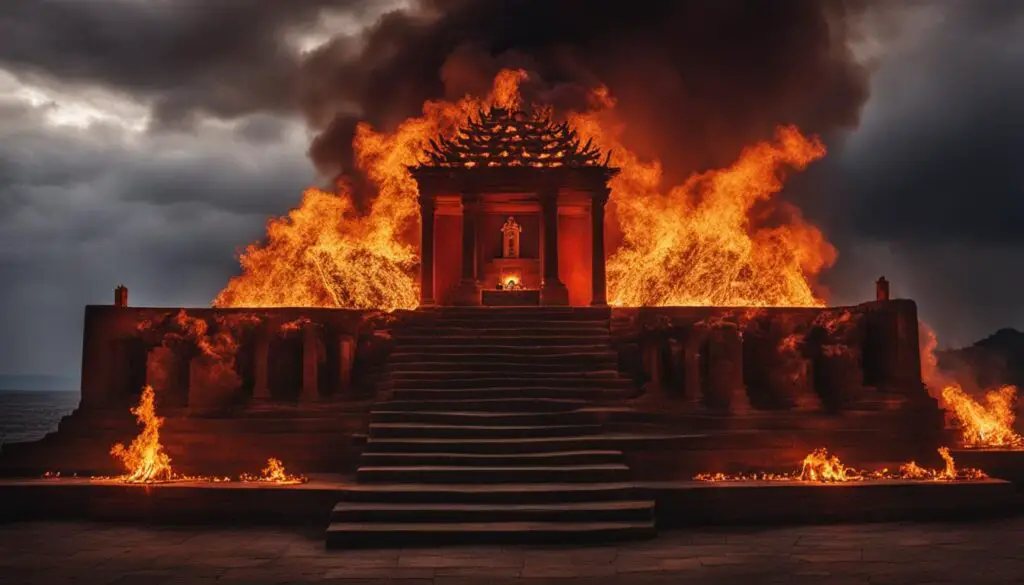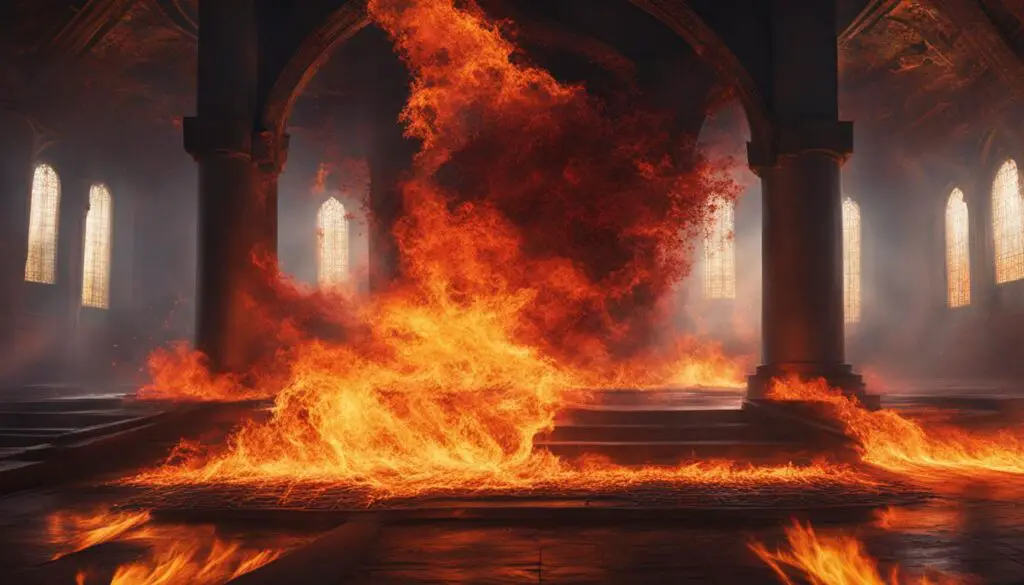In the Bible, fire carries profound symbolism and represents various aspects of God’s presence, judgment, purification, and transformation. As we explore the significance of fire in the Old and New Testaments, we will delve into its symbolic meaning, cultural and historical context, and references in specific Bible verses. From the burning bush to the tongues of fire at Pentecost, fire holds a multifaceted role in the sacred text.
Fire in the Bible is a powerful symbol, representing both protection and destruction. It signifies God’s presence and divine judgment, purifying and transforming individuals and nations. The cultural and historical context of fire adds depth to its meaning, allowing us to uncover spiritual insights within the text. By examining references to fire in specific Bible verses, we can gain a deeper understanding of its complex symbolism and significance.
Key Takeaways:
- Fire in the Bible represents God’s presence, judgment, purification, and transformation.
- It symbolizes both protection and destruction throughout the sacred text.
- The burning bush and the tongues of fire at Pentecost are notable instances of fire’s significance in the Bible.
- Fire serves as a symbol of divine judgment against sinfulness and disobedience.
- Understanding the cultural and historical context enriches our interpretation of fire’s symbolism in the Bible.
The Symbolism of Fire in the Bible
Fire in the Bible holds deep symbolism, representing the divine presence, divine judgment, purification, transformation, protection, and destruction. Its significance is multifaceted and appears throughout the sacred text, offering profound insights into the nature of God and the spiritual journey of believers. In numerous instances, fire serves as a powerful and transformative symbol, emphasizing the awe-inspiring nature of the divine.
One notable aspect of the symbolism of fire in the Bible is its association with theophanies, highlighting the presence of God. The burning bush encountered by Moses in Exodus is a prime example. As Moses approached the bush, he witnessed flames but was astonished that it did not consume the plant. The burning bush represented God’s eternal and transformative nature, capturing Moses’ attention and setting the stage for God’s powerful revelation.
Fire is also closely linked to divine judgment and destruction. The Old Testament includes accounts of cities like Sodom and Gomorrah being consumed by fire as a consequence of extreme sinfulness. These narratives underscore the seriousness of disobedience and the consequences that follow. Additionally, fire serves as a refining agent, symbolizing the purification of believers. It is likened to the process of refining gold in a furnace, emphasizing the transformative power of God’s presence and the shaping of character through life’s trials.
| Symbolism of Fire in the Bible | Related Concepts |
|---|---|
| Divine Presence | Theophanies, Burning Bush |
| Divine Judgment | Destruction of Sodom and Gomorrah |
| Purification | Refining Quality, Testing by Fire |
| Transformation | Renewal, Growth, Spiritual Development |
| Protection | Pillar of Fire, God’s Guidance |
| Destruction | Consequences of Sin, God’s Wrath |
As believers engage with the symbolism of fire in the Bible, they are invited to reflect on the divine presence, judgment, and transformation in their own lives. Fire serves as a reminder of God’s power, holiness, and refining work in the lives of individuals and communities. It prompts introspection, inviting believers to examine their own spiritual journey and draw closer to the divine flame that guides and purifies.
The Burning Bush in the Bible
The burning bush is a significant symbol in the Bible, representing God’s presence, transformative power, and holiness. In Exodus 3, Moses encounters a bush that is on fire but not consumed. This miraculous sight captures his attention, and he draws near to investigate. As he approaches the burning bush, a voice from within speaks to him, declaring, “I am the God of your father, the God of Abraham, the God of Isaac, and the God of Jacob” (Exodus 3:6). This encounter marks a pivotal moment in Moses’ life and sets the stage for God’s plan to deliver the Israelites from Egyptian bondage.
“When the LORD saw that he turned aside to see, God called to him out of the bush, ‘Moses, Moses!’ And he said, ‘Here I am.’ Then He said, ‘Do not come near; take your sandals off your feet, for the place on which you are standing is holy ground.’ And He said, ‘I am the God of your father, the God of Abraham, the God of Isaac, and the God of Jacob.’” – Exodus 3:4-6
The burning bush represents God’s eternal nature and transformative power. It symbolizes the divine presence, as Moses is instructed to remove his sandals because he is standing on holy ground. Through the burning bush, God reveals Himself to Moses and commissions him to lead the Israelites out of Egypt. This encounter demonstrates the profound impact that encountering God’s presence can have on an individual’s life, as Moses’ life is forever changed by this divine encounter.
The Significance of the Burning Bush
The burning bush is a powerful symbol of God’s presence, transformative power, and holiness. It serves as a reminder that God is eternal and unchanging, able to work through the ordinary and the extraordinary to accomplish His purposes. The burning bush also highlights the holiness of God and the importance of approaching Him with reverence and awe. It emphasizes that when we encounter God’s presence, we are standing on holy ground and should humbly submit ourselves to His will.
The Transformative Power of the Burning Bush
The burning bush represents the transformative power of God. Just as the bush is on fire but not consumed, God’s power is not diminished or extinguished. Instead, encountering God’s presence can ignite a fire within us, transforming our lives and empowering us to fulfill His purposes. The burning bush reminds us that God can use ordinary people for extraordinary purposes when we are willing to surrender ourselves to Him. It is a symbol of hope, reminding us that God can bring about transformation and deliverance, even in the midst of the most impossible situations.
The Significance of Fire in Biblical Stories and Teachings
Fire plays a significant role in various biblical narratives and teachings, symbolizing important concepts such as confirmation of covenants, protective guidance, the Holy Spirit’s descent, and refining quality. These symbolic representations deepen our understanding of God’s presence and His transformative power.
In biblical stories, fire acts as confirmation of covenants, signifying an agreement or promise made between God and His people. One example can be found in Genesis 15, where God confirms His covenant with Abram through a burning torch and a smoking firepot. This divine manifestation assures Abram of God’s faithfulness and establishes the covenant between them.
Fire also serves as a source of protective guidance in biblical narratives. For instance, the pillar of fire leads the Israelites through the wilderness during their exodus from Egypt. This supernatural occurrence not only illuminates their path but also reassures them of God’s presence and guidance in their journey towards the Promised Land. The pillar of fire serves as a visible symbol of God’s protection and direction.
“And the Lord went before them by day in a pillar of cloud to lead the way, and by night in a pillar of fire to give them light, so as to go by day and night.” – Exodus 13:21
The Holy Spirit’s descent at Pentecost is another significant biblical event associated with fire. As described in Acts 2, the Holy Spirit came upon the disciples in the form of tongues of fire, empowering and equipping them for their mission to spread the gospel. This transformative encounter marked the birth of the early Christian Church and highlights the role of fire in the spiritual development of believers.
Furthermore, fire’s refining quality is emphasized in biblical teachings. Just as gold is refined through fire to remove impurities, believers undergo trials and challenges that refine their faith and character. The Apostle Peter refers to this refining process in his first epistle, comparing it to gold tested by fire. These teachings underscore the transformative power of fire in shaping and purifying the lives of believers.
Overall, the significance of fire in biblical stories and teachings goes beyond its literal interpretation. Fire symbolizes confirmation, protection, transformation, and refining, offering profound insights into God’s relationship with His people and His desire for their spiritual growth.
| Symbolism | Biblical References |
|---|---|
| Confirmation of Covenants | Genesis 15:17 |
| Protective Guidance | Exodus 13:21 |
| Holy Spirit’s Descent | Acts 2:3-4 |
| Refining Quality | 1 Peter 1:7 |
Fire in the Old Testament
Fire plays a significant role in the Old Testament, symbolizing God’s presence, power, judgment, destruction, and purification of sins. Throughout the sacred text, fire is used as a powerful symbol to signify the multifaceted nature of God and His relationship with humanity. It serves as a visual representation of His divine presence, often accompanying theophanies and emphasizing His holiness and power.
In the context of judgment, fire is associated with the destruction of cities and nations, such as Sodom and Gomorrah. These instances showcase God’s wrath against extreme sinfulness and serve as a reminder of the consequences of disobedience. Fire also plays a role in the purification of sins, as seen in the consumption of offerings presented to God. This symbolizes the cleansing and renewal of the individual or community.
One notable example of fire in the Old Testament is the pillar of fire that guided the Israelites through the wilderness. This pillar represented God’s protective presence and provided guidance to the Israelites on their journey. It symbolized both protection from external threats and the divine presence that accompanied them.
Fire’s presence and symbolism in the Old Testament highlight the complex nature of God and His relationship with His people. It serves as a reminder of His power, judgment, and purification, emphasizing the need for reverence and obedience. Through the imagery of fire, the Old Testament conveys the profound significance of God’s presence in the lives of His people.
The Symbolism of Fire in the Old Testament
| Symbolism | Meaning |
|---|---|
| God’s Presence | Fire represents the visual manifestation of God’s presence, emphasizing His holiness and power. |
| Divine Judgment | Fire symbolizes God’s wrath against extreme sinfulness and disobedience. |
| Destruction | Fire serves as a tool of destruction, showcasing the consequences of disobedience and the seriousness of sin. |
| Purification of Sins | Fire is used to consume offerings presented to God, symbolizing the cleansing and renewal of the individual or community. |
| Protection | The pillar of fire guided and protected the Israelites in their journey through the wilderness. |
Fire in the New Testament
Fire continues to hold significant symbolism in the New Testament, representing themes of judgment, transformation, and divine presence. It is utilized as a powerful metaphor to convey spiritual truths and convey God’s character and intentions.
The Final Judgment and Hell
In the New Testament, fire is associated with the final judgment and the concept of hell. Jesus speaks of unquenchable fire, which represents the eternal consequences of unrepentant sin. This imagery is intended to emphasize the seriousness of moral choices and the need for spiritual transformation. The fire of judgment serves as a reminder that accountability awaits those who reject God’s grace and choose a life apart from Him.
The Transformative Power of Fire at Pentecost
One of the most notable instances of fire in the New Testament is at Pentecost when the Holy Spirit descends upon the disciples as tongues of fire. This imagery symbolizes the transformative power of God’s presence and the empowerment of believers for ministry. The fire serves as a catalyst, igniting the hearts and minds of the disciples and enabling them to proclaim the gospel with boldness and effectiveness.
“And divided tongues as of fire appeared to them and rested on each one of them. And they were all filled with the Holy Spirit and began to speak in other tongues as the Spirit gave them utterance.” – Acts 2:3-4
This outpouring of the Holy Spirit marked a significant moment in the early church, illustrating the ongoing role of fire as a symbol of God’s transformative work and the enablement of believers.
| Symbolic Meaning | Reference |
|---|---|
| Judgment | Matthew 3:10-12 |
| Purification and Refinement | 1 Corinthians 3:13-15 |
| Transformative Power | Acts 2:3-4 |
Through these examples, it is evident that fire in the New Testament holds a dual nature, representing both judgment and transformation. It serves as a powerful symbol of the consequences of sin and the need for repentance, as well as the transformative work of the Holy Spirit in believers’ lives. The imagery of fire reinforces the urgency of choosing a life in alignment with God’s will and the potential for radical transformation through His grace.

Table: Fire Symbolism in the New Testament
| Symbolic Meaning | Reference |
|---|---|
| Judgment | Matthew 3:10-12 |
| Purification and Refinement | 1 Corinthians 3:13-15 |
| Transformative Power | Acts 2:3-4 |
Fire from Heaven
Fire from heaven holds significant meaning in the Bible, symbolizing both divine judgment and divine approval. Throughout the scriptures, fire is depicted as a powerful manifestation of God’s authority and power. It serves as a symbol of God’s judgment, consuming and destroying those who have acted against His will.
“And Elijah came near to all the people and said, ‘How long will you go limping between two different opinions? If the Lord is God, follow him; but if Baal, then follow him.’ And the people did not answer him a word. Then Elijah said to the people, ‘I, even I only, am left a prophet of the Lord, but Baal’s prophets are four hundred and fifty men. Let two bulls be given to us, and let them choose one bull for themselves and cut it in pieces and lay it on the wood, but put no fire to it. And I will prepare the other bull and lay it on the wood and put no fire to it. And you call upon the name of your god, and I will call upon the name of the Lord, and the God who answers by fire, he is God.’ And all the people answered, ‘It is well spoken.’”
In this passage, we see how fire from heaven is used as a demonstration of God’s power and authority. Elijah challenges the prophets of Baal to a contest, where they each prepare a sacrifice and call upon their respective gods to consume it with fire. The God who answers by fire is proclaimed as the one true God. In this instance, fire from heaven symbolizes divine approval, confirming the authenticity of Elijah’s message and reinforcing the faith of the people.
| Event | Symbolism |
|---|---|
| Destruction of Sodom and Gomorrah | Divine judgment upon extreme sinfulness |
| Challenge on Mount Carmel | God’s power and authority demonstrated through fire |
| Consumption of sacrifices | Divine acceptance and approval |
This table summarizes some key instances of fire from heaven in the Bible, showcasing its various symbolic meanings. From the destruction of Sodom and Gomorrah to the consumption of sacrifices, fire from heaven serves as a powerful sign of God’s judgment and approval. It reminds us of the consequences of disobedience and the importance of aligning ourselves with God’s will.
Destruction, Judgment, Warning, and Demonstration of Power
In the Bible, fire is often associated with destruction, judgment, warning, and the demonstration of God’s power. Throughout the sacred text, there are several instances where God sends fire from heaven as a form of punishment or as a demonstration of His authority. These manifestations of fire serve as warnings to the people and highlight the consequences of disobedience. They also showcase the immense power and authority of God.
One notable example of fire being used as a form of destruction is the story of Sodom and Gomorrah. In Genesis 19, these cities were destroyed by fire and brimstone from heaven as a punishment for their extreme sinfulness. This event serves as a warning to all readers about the seriousness of sin and the consequences that follow.
Another example is found in 1 Kings 18, where the prophet Elijah challenges the prophets of Baal to a test to determine who the true God is. The prophets of Baal were unable to ignite their altar with fire, while Elijah’s altar was consumed by fire from heaven, demonstrating the power and authority of the one true God.
| Event | Description |
|---|---|
| The destruction of Sodom and Gomorrah | Genesis 19:24 – “Then the Lord rained down burning sulfur on Sodom and Gomorrah—from the Lord out of the heavens.” |
| Elijah challenges the prophets of Baal | 1 Kings 18:38 – “Then fire of the Lord fell and consumed the burnt offering and the wood and the stones and the dust, and licked up the water that was in the trench.” |
| Consumption of sacrifices by Aaron and Solomon | Leviticus 9:24 – “And fire came out from before the Lord and consumed the burnt offering and the pieces of fat on the altar.” 2 Chronicles 7:1 – “As soon as Solomon finished his prayer, fire came down from heaven and consumed the burnt offering and the sacrifices, and the glory of the Lord filled the temple.” |
These instances of fire from heaven serve as powerful reminders of God’s sovereignty and the importance of obedience. They illustrate that God has the ultimate authority to judge and punish those who rebel against Him. As readers engage with these stories, they are encouraged to reflect on their own lives and ensure they are living in accordance with God’s commands.
The demonstrations of God’s power through fire also emphasize His ability to protect and deliver His people. They provide a sense of awe and reverence for the divine, highlighting the need for faithfulness and devotion to God.
Key Takeaways:
- God uses fire as a form of destruction, judgment, warning, and to demonstrate His power.
- The destruction of Sodom and Gomorrah and Elijah’s challenge to the prophets of Baal are notable examples of fire being used in the Bible.
- These instances serve as warnings and reminders of the consequences of disobedience.
- They also highlight God’s power and authority, emphasizing the need for obedience and devotion.
Fire in the Context of Godly Jealousy

Fire in the Bible is not only a symbol of divine judgment and purification but also represents the concept of godly jealousy. When we think of jealousy, we often associate it with negative emotions and possessiveness. However, in the context of God, jealousy takes on a different meaning. It represents a burning desire for a deep and intimate relationship with His people.
God’s jealousy is like a consuming fire, passionately desiring the loyalty and devotion of His people. Just as fire consumes everything in its path, God’s jealousy burns away anything that stands between Him and His beloved. It serves as a reminder of His presence and holy zeal for His people to remain faithful to Him alone.
In Exodus 34:14, God declares Himself as a “jealous God.” He desires wholehearted worship and devotion from His people. This godly jealousy reflects His deep love for us and the longing for us to prioritize Him above all else. Just as fire refines and purifies, God’s jealousy refines our hearts and calls us into a deeper, more intimate relationship with Him.
Fire as a Symbol of God’s Wrath and Judgment
In the Bible, fire serves as a powerful symbol of God’s wrath and judgment. It represents the destructive power that is unleashed in response to extreme sinfulness and disobedience. Throughout the sacred text, there are numerous examples where fire is used to demonstrate God’s righteous anger and the consequences that follow.
One notable example is the destruction of Sodom and Gomorrah, where fire rained down from heaven and obliterated the wicked cities. This event serves as a stark warning of the consequences of rampant sinfulness and rebellion against God’s commandments.
In the book of Revelation, fire is also associated with God’s final judgment. It is described as a lake of fire, where the wicked will experience eternal punishment for their transgressions. This depiction highlights the seriousness of sin and the righteous judgment that awaits those who reject God’s grace.
| Examples of God’s Wrath and Judgment through Fire | Biblical References |
|---|---|
| Destruction of Sodom and Gomorrah | Genesis 19:24-25 |
| The account of Nadab and Abihu’s unauthorized fire | Leviticus 10:1-2 |
| The offering of strange fire by the sons of Aaron | Leviticus 10:1-2 |
| The consumption of the wicked by fire in Sheol/Hell | Psalm 11:6 |
| The judgment described in the book of Revelation | Revelation 20:14-15 |
These instances of God’s wrath and judgment through fire emphasize the seriousness of sin and the need for repentance. They serve as a reminder of the consequences that await those who persist in rebellion against God’s righteous standards.

The Consequences of Sin: A Fiery Warning
“For our God is a consuming fire.” – Hebrews 12:29
The Bible’s portrayal of fire as a symbol of God’s wrath and judgment serves as a powerful reminder of the consequences of sin. It underscores the urgency for individuals to turn away from wickedness and embrace God’s forgiveness and grace. Fire represents the seriousness of our actions and the ultimate accountability we will face before a just and holy God.
However, it is important to note that God’s judgment is not arbitrary or vindictive. It is a response to human sinfulness and rebellion against His righteous standards. Through His judgment, God seeks to bring justice, restore order, and ultimately reconcile humanity back to Himself.
In light of the symbolic significance of fire in the Bible, it is a solemn reminder of the need for repentance and the importance of living in alignment with God’s will. It prompts introspection and self-examination, inviting individuals to evaluate their own lives and seek forgiveness and transformation through the redemptive work of Jesus Christ.
Modern Interpretations of Biblical Fire
In modern times, the interpretation of biblical fire continues to offer spiritual insight and inspiration. The symbol of fire in the Bible represents God’s presence, divine judgment, renewal, and introspection. It challenges us to consider how we encounter and respond to the divine fire in our lives. Whether it is a refining fire or a consuming fire, the symbolism of fire remains relevant in our understanding of God and our spiritual growth.
When we encounter the symbol of fire in the Bible, it invites us to gain spiritual insight. Just as fire illuminates and reveals, it calls us to examine ourselves and seek a deeper connection with God. It prompts us to reflect on our own lives and actions, inviting introspection and self-examination. Through this process, we can experience renewal and transformation, allowing the divine fire to refine our hearts and purify our spirits.
“The fire shall ever be burning upon the altar; it shall never go out.” – Leviticus 6:13
As we engage with the symbol of fire, we are reminded of God’s continuous presence and judgment. Fire symbolizes the eternal flame that burns upon the altar, representing God’s everlasting presence. It serves as a reminder that God is always with us, guiding us, and calling us to live according to His truth. The symbol of fire also reminds us of the reality of divine judgment, urging us to seek righteousness and live in alignment with God’s will.
Inspiring Introspection
As we navigate our spiritual journey, the symbol of fire invites us to pause and reflect. It prompts us to examine our thoughts, actions, and motives. Are we living with integrity and authenticity? Are we allowing the fire of God’s presence to ignite our hearts with passion for Him? Are we open to the refining and transformative work that the divine fire desires to accomplish within us?
By embracing the symbolism of fire in the Bible, we can cultivate a deeper understanding of God’s presence, judgment, renewal, and introspection. It challenges us to pursue spiritual growth and live in awe of the divine fire that burns within and around us. As we strive to engage with the symbol of fire, may it ignite a greater passion for God, purify our hearts, and lead us to a closer relationship with Him.

Conclusion
The symbolism of fire in the Bible holds profound significance, representing God’s presence, divine judgment, purification, and transformation. Throughout the Old and New Testaments, fire serves as a powerful symbol that conveys both protection and destruction. It reflects the multifaceted nature of God’s power and holiness.
Understanding the symbolism of fire provides spiritual insight and guidance for our journey. It deepens our understanding of God’s character and illuminates the lessons embedded in the biblical text. Fire confirms covenants, guides, and refines believers, reminding us of the transformative power of God’s presence.
As we engage with the sacred text, let us embrace the profound significance of fire. May we recognize the divine presence, heed the warnings of divine judgment, and seek purification and renewal through God’s transformative fire. The symbolism of fire in the Bible continues to be relevant and impactful, inviting us to reflect on our spiritual journey and embrace the fullness of God’s love and power.
FAQ
What does fire symbolize in the Bible?
Fire in the Bible symbolizes God’s presence, divine judgment, purification, and transformation. It represents both protection and destruction.
How many times is fire mentioned in the Bible?
Fire is mentioned approximately 500 times in the Bible.
What is the significance of the burning bush in the Bible?
The burning bush in the Bible represents God’s eternal nature and transformative power. It signifies the divine presence and holiness.
How does fire play a role in biblical stories and teachings?
Fire confirms covenants, serves as protective guidance, represents the descent of the Holy Spirit, and symbolizes the refining quality.
How is fire associated with God’s presence in the Old Testament?
Fire represents God’s presence, power, judgment, destruction, and the purification of sins in the Old Testament.
What is the significance of fire in the New Testament?
In the New Testament, fire is associated with judgment, hell, the final judgment, and the transformative power of the Holy Spirit’s descent at Pentecost.
What does fire from heaven symbolize in the Bible?
Fire from heaven represents divine judgment and divine approval in various biblical accounts.
When does God send fire from heaven in the Bible?
God sends fire from heaven as a form of destruction, judgment, warning, and demonstration of power in several instances in the Bible.
What does fire symbolize in the context of Godly jealousy?
Fire symbolizes God’s burning desire and consuming fire, representing His jealous nature and holy zeal.
What does fire symbolize as a symbol of God’s wrath and judgment?
Fire symbolizes the destructive power unleashed in response to extreme sinfulness and disobedience, highlighting the seriousness of sin and its consequences.
How is fire interpreted in modern times?
In modern times, the interpretation of biblical fire offers spiritual insight, prompting introspection and reflection on our spiritual journey.
What is the overall significance of fire in the Bible?
Fire holds profound meaning in the Bible, symbolizing God’s presence, divine judgment, purification, transformation, protection, and destruction.







